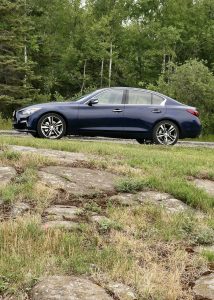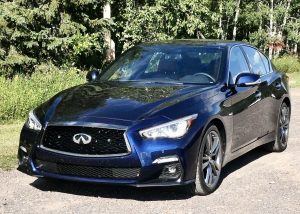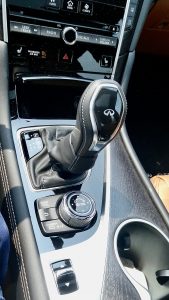Infiniti Q50 adds AWD to upscale bargain
By John Gilbert
The “big three” Japanese automakers have been dominant in the U.S. auto market for several decades, and as good as utilitarian Honda, Toyota and Nissan models have been, all three have upscale brands that have branched off from the mother ships and made their own way to the top.
At Toyota, that would be Lexus; Honda has Acura; and Nissan has Infiniti. In most cases, the companies push their newest technology out to the public in those upscale brands, and in some cases there is no comparison between the top tech of those and the basic stuff. Toyota, for instance, uses Lithium-ion battery packes on Lexus hybrids compared to nickel-metal-hydride on Toyotas; Honda uses new engines in Acuras, and Nissan uses more potent engines and veers away from dependence on only CVTs in its Infinitis.
In the recent economic drop-off, those companies are reeling in some of their more futuristic vehicles, retrenching in the face of the threat of sales dropoffs.
Some of the Infiniti models may lack the promotional punch of the Lexus and Acura vehicles, but at our house, we figure a couple of Infinitis make our all-time favorite list.
A perfect example is the 2021 Infiniti Q50 sedan, which I recently spent a week driving on the North Shore of Lake Superior. The pleasure of driving such a precise and sporty-performing sedan with climate-control blowing air conditioning throughout the cabin, easily outclasses the discomfort of enduring the outrageous 90-degree heat we’ve been feeling most of this sizzling summer.
The particular model we drove was a Signature Edition, which had extra features inside and out, including a couple that are far too significant to have escaped scrutiny in Motor Trend’s annual new-car-capsule edition. Motor Trend’s “experts” seemed to look for all sorts of reasons to put down the Q50 as less worthy than competitive cars, and while claiming the 2021 model is “unchanged” from the 2020 version, overlooked such details as the 300 horsepower or 295 foot-pounds of torque from the 3.0-liter twin-turbocharged V6.
Also overlooked in their snarky evaluation is the fact that the new Signature Edition has Nissan’s “Intelligent” all-wheel-drive system, accessed by a console switch to allow you to direct the power via the 7-speed automatic transmission to all four wheels when you perceive the need. Such an addition, you might think, would elevate the Q50 up to or beyond the competitors in that segment, instead of trailing. And we got over 25 miles per gallon with all that power available, and that was overall, with most of our driving up the hills of Duluth.
But before we blame Motor Trend too much, Nissan/Infiniti itself needs to be called to account in its Monroney sheet of vehicle details for pointing out that the tester’s sticker price of $52,800 includes $695 for “Premium Paint,” but it fails to inform us what the name of that color is. Paint colors are one place where manufacturers can exercise all sorts of cleverly creative hyperbole. But while you can get away with kissing off black or white as, say, black or white, the test car was a stunning dark blue, which sent me scurrying for the sticker sheet to identify the color.
I admit to being a “blue” person, to the point where my wife, Joan, often downplays blue things because she knows I’ll like them too much. But the Q50 Signature was such a riveting dark blue that Joan pointed out to me how much she liked it before I even had the chance to rave about it. It’s so dark that it appears black in subdued light or at nighttime, but when the sun hits it, the dark blue penetrates your senses.
It also makes the bright silver on the aluminum 19-inch wheels an impressive accent, although Joan and I agreed we’d prefer brushed alloy to let the color be even more prominent.

Leather seats and feature-filled interior includes drive-mode and AWD control switches on the console.
In the annual battle to beat the competition out with features, a couple of Nissan’s major achievements have been in accident-avoidance technology, and in the tech-screen display of monitoring anything you might be backing up toward. While others were coming out with impressive rear-view camera views, Nissan was the first I experienced with full 360-degree surround video in some Infinitis, which showed the ability to scrutinize anything within several feet of your road space in all directions.
On the new Q50, if you hit the right setting you get a top-down perspective of your vehicle with a moat around it, preferably free of any objects. And in their best simplicity, Infiniti calls the system “AroundView Monitor with Moving Object Detection.” That view is in addition to the car’s innate ability for automatic collision notification, predictive forward collision warning, blind-spot warning, lane-departure warning and back-up collision intervention.
All that stuff is standard on the $50,000 Signature version, as is the hill-start assist, adaptive cruise control with distance-control assist, and active trace assist, which can use all those electronic features to keep you in your lane around curves. Naturally, with all those ingredients, linking up with your smart phone is a given, as is the navigation system.
Going back to Nissan’s early sports-car days, with the 240Z and since then, the company has put a premium on sporty and precise handling, and the Q50 snakes around curves as if on those sports-car rails, making it enjoyable to drive and also comfortable both in the passenger and rear seat. A switch on the console lets you pick standard, eco, sport, personal, or snow/ice, for handling or traction needs.
All of those seating surfaces were covered a rich and soft leather.
Also, all the driving enjoyment was amplified — literally — by the Bose 15-speaker audio system, which filled the interior with sounds of your choosing. In fact, so good was the audio system that we spent seven solid days of driving the car before, on the final morning, discovering a neat little horizontal trim line near the audio controls; it was not a trim line, but a CD player! I love CD players, which almost all new cars don’t bother installing any more, I give added gold stars to any that do, because all of us, right up to the biggest MP3 addicts, have shelves or drawers full of CDs, and you would love to be able to play them while on the road.
Maybe if the Q50 had fewer gadgets and features, I might have noticed the CD slot a lot sooner, but I’m going to blame Infiniti for not boasting about it more or at least pointing it out.
If that is the ultimate nitpick, I have one more complaint in such a near-perfect car. OK, two other complaints. One is that the heated seats lacked the more-recent trend of having perforated leather that allows cooled air to circulate and keep you infinitely cooler on hot days. My car doesn’t have them either, but I’ve appreciated them on many of the vehicles I’ve driven since Climate Change decided to fry us all, and I’m sure you could probably find them on the option list for the Q50. But if I’m calling this one of the best near-premium, sports-luxury sedans for the bargain price of $52,800, then cool off my backside, OK?,
My other suggestion is that the Q50’s 7-speed automatic is smooth-shifting and precise, but it lacks steering-wheel paddles, which, with such tremendously responsive power, would be an ideal feature. Maybe they were left behind because the steering wheel already is loaded up with remote controls, but they would advance the pleasure of accelerating or decelerating — especially on hills, where downshifting is the best brake preservative on the planet.
Maybe such things are available for a few more bucks, but those two features are significant enough that one of them would add to the luxury image and the other to the sporty image. Maybe they wanted to see if Motor Trend would notice.






 John Gilbert is a lifetime Minnesotan and career journalist, specializing in cars and sports during and since spending 30 years at the Minneapolis Tribune, now the Star Tribune. More recently, he has continued translating the high-tech world of autos and sharing his passionate insights as a freelance writer/photographer/broadcaster. A member of the prestigious North American Car and Truck of the Year jury since 1993. John can be heard Monday-Friday from 9-11am on 610 KDAL(www.kdal610.com) on the "John Gilbert Show," and writes a column in the Duluth Reader.
John Gilbert is a lifetime Minnesotan and career journalist, specializing in cars and sports during and since spending 30 years at the Minneapolis Tribune, now the Star Tribune. More recently, he has continued translating the high-tech world of autos and sharing his passionate insights as a freelance writer/photographer/broadcaster. A member of the prestigious North American Car and Truck of the Year jury since 1993. John can be heard Monday-Friday from 9-11am on 610 KDAL(www.kdal610.com) on the "John Gilbert Show," and writes a column in the Duluth Reader.